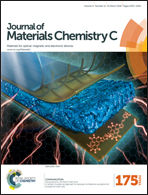Robust room-temperature inversion-asymmetry topological transitions in functionalized HgSe monolayer
Abstract
The new quantum materials known as inversion-asymmetry topological insulators (IATIs) have recently drawn intense attention because these structures possess distinct properties from those of inversion-symmetry insulators. However, the reported IATIs are rare in monolayer structures thus far. On the basis of first-principles calculations, we predict that the two-dimensional I-decorated HgSe monolayer (HgSeI2) is a new IATI with a large gap of 59.1 meV, as well as large Rashba spin splitting (RSS) of 37.2 meV, which derives from the polarity of atoms. The topological characteristic is confirmed by the s–pxy band inversion, topological invariant Z2, and time-reversal symmetry-protected helical edge states. The topologically nontrivial band gap and RSS of HgSeI2 can be effectively modulated with a wide range of strain (−12 to 6%) and external electric field (−10 to 10 V nm−1), and the maximum band gap can be improved to 156 meV under compressive strain, while other F-, Cl-, and Br-decorated cases can transform from trivial to nontrivial TIs with respect to appropriate strain. These novel IATIs with controlled band gap and RSS provide excellent platforms to realize topological spintronic devices based on inversion-asymmetry films.


 Please wait while we load your content...
Please wait while we load your content...